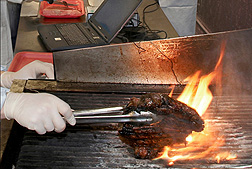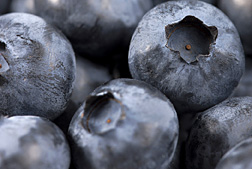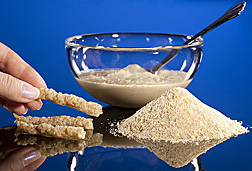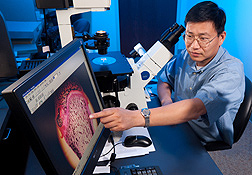|
October 2011 |
Does Grilling Kill E. coli O157:H7?Agricultural Research Service (ARS) scientists are learning more about the movement of Escherichia coli into "subprimals," the meat from which top sirloin steaks are carved. The focus is on what happens to the E. coli when subprimals are punctured as part of the tenderization process, and the effect of cooking on survival of those microbes. In early studies, the researchers applied various levels of E. coli O157:H7 to the "lean-side" surface of subprimals and ran the meat, lean side up, through a blade tenderizer. In general, only 3 to 4 percent of the E. coli O157:H7 cells were transported to the geometric center of the meat. Next, the group applied E. coli to the lean-side surface of more subprimals, put the meat through a blade tenderizer, then sliced it into steaks and cooked the meat on a commercial open-flame gas grill. The findings confirmed that if a relatively low level of E. coli O157:H7 is distributed throughout a blade-tenderized top sirloin steak, proper cooking on a commercial gas grill is effective for eliminating the microbe. For details, contact: John B. Luchansky, (215) 233-6620, Food Safety and Intervention Technologies Unit, ARS Eastern Regional Research Center, Wyndmoor, Pa. |
|
|
|
Mammary Gland Development of Blueberry-fed Lab Animals Studied
For details, contact: Rosalia C. M. Simmen, (501) 364-2847, ARS Arkansas Children's Nutrition Center, Little Rock, Ark. |
New Freeze-dry Method Good for Processing FishA quicker freeze-dry technique used to process salmon cubes could potentially add value to fish components considered to be less appealing. The new freeze-dry method, which requires less energy and processing time, was developed by Agricultural Research Service (ARS) scientists in collaboration with scientists at the University of Alaska-Fairbanks. The scientists created a process that took only nine hours, raising the temperature from minus 40 degrees Fahrenheit to 32 degrees Fahrenheit. Traditional processing can take 20 hours or more. The new method removed 97 percent of the moisture from fillets of Alaska's most abundantly harvested Pacific salmon species—pink, sockeye and chum. The freeze-dried salmon cubes maintained their original color, rehydrated quickly and shrank less in a shorter period of time than food processed by traditional freeze-drying. For details, contact: Peter Bechtel, (907) 486-1531, ARS Subarctic Agricultural Research Unit, Fairbanks, Alaska. |
|
|
|
Researchers Develop Fully Cooked Food-Aid Product
For details, contact: Charles Onwulata, (215) 233-6497, Dairy and Functional Foods Unit, ARS Eastern Regional Research Center, Wyndmoor, Pa. |
Scientists Help Keep Salad Mixes SafeInnovative studies by Agricultural Research Service (ARS) scientists are providing new information about the impressive array of genes that a major foodborne pathogen, E. coli O157:H7, calls into action when attempting to colonize leaves of fresh-cut lettuce. Mechanical cutting of lettuce leaves into large pieces or shredding of leaves into narrow strips, like those in taco filling, breaks the lettuce cells, which exude carbohydrates that E. coli can use as a source of energy. But injured cells can also leak natural compounds such as antimicrobials that are problematic for the pathogen. A study with romaine lettuce showed that E. coli can adapt quickly when exposed in lab tests to the contents of broken lettuce leaf cells. Using an approach known as microarray-based whole genome transcriptional profiling, the researchers determined that the pathogen uses its genetic arsenal to protect itself against not only the antimicrobial compounds, but also against oxidative stress, osmotic stress, damage to its DNA and other threats to its ability to survive and multiply. For details, contact: Maria T. Brandl, (510) 559-5885, Produce Safety and Microbiology Research Unit, ARS Western Regional Research Center, Albany, Calif. |
|
|
|
Blueberries Help Lab Rats Build Strong BonesCompounds in blueberries might turn out to have a powerful effect on formation of strong, healthy bones, if results from studies with laboratory rats turn out to hold true for humans. The Agricultural Research Service (ARS) studies showed that rats fed rations that contained 10 percent freeze-dried blueberry powder had significantly more bone mass than their counterparts whose rations were blueberry-free. When the researchers exposed laboratory cultures of bone-forming cells (osteoblasts) to blood (serum) from the animals, they found that serum from the blueberry-fed rats was associated with an increase in development of osteoblasts into mature, functional bone cells. The work has paved the way for new research that might reveal whether blueberries could be used in the future in treatments to boost development of bone mass and to help prevent osteoporosis. For details, contact: Jin-Ran Chen, (501) 364-2707, Skeletal Development Laboratory, ARS Arkansas Children's Nutrition Center, Little Rock, Ark. |
E. coli Can Survive in Streambed Sediments for MonthsAgricultural Research Service (ARS) studies have confirmed that the presence of E. coli pathogens in surface waters could result from the pathogen's ability to survive for months in underwater sediments. Most E. coli strains don't cause illness, but they are indicator organisms used by water quality managers to estimate fecal contamination. Lab studies conducted suggested that non-pathogenic strains of E. coli can survive much longer in underwater sediments than in the water column itself, and provided the first published evidence that E. coli can overwinter in the sediment. The results also indicated that the pathogens lived longer when levels of organic carbon and fine sediment particles in the sediment were higher. In addition, when organic carbon levels were higher, water temperatures were less likely to affect the pathogens' survival rates. For details, contact: Yakov Pachepsky, (301) 504-7468, Environmental Microbial and Food Safety Laboratory, ARS Henry A. Wallace Beltsville Agricultural Research Center, Beltsville, Md. |
|
|
|
New Flavors Emerge from Peruvian Cacao Collection TripNew cacao types with unique flavors that are distinctly Peruvian have been identified Agricultural Research Service (ARS) scientists. These new flavors could one day be marketed like fine wine, by geographical provenance. The ARS researchers and their Peruvian collaborators found these new cacao plants during collection expeditions in 2008 and 2009 in the Amazon Basin of Peru. The researchers are studying 342 cacao specimens collected from 12 watersheds in Peru and categorizing the DNA of the specimens. For details, contact: Lyndel Meinhardt, (301) 504-1995, Sustainable Perennial Crops Laboratory, ARS Henry A. Wallace Beltsville Agricultural Research Center, Beltsville, Md. |
ARS Nutrition Resources on the Internet
Dietary Supplement Ingredient Database Food and Nutrient Database for Dietary Studies What We Eat in America ARS Human Nutrition Research Program Functional Foods Research in ARS |
|
|
|
ARS Human Nutrition LaboratoriesGrand Forks Human Nutrition Research Center Western Human Nutrition Research Center Children's Nutritional Research Center Beltsville Human Nutrition Research Center Delta Obesity Prevention Research Unit |











